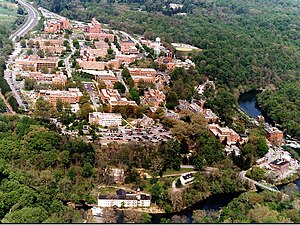
The DuPont Experimental Station is the largest research and development facility of DuPont,[1] located on the banks of the Brandywine Creek in Wilmington, Delaware
Overview[edit]
The DuPont Experimental Station was founded as an effort to move the DuPont Company from gunpowder and explosives into chemistry.[1] The site overlooks the original powder mills upon which the company was founded – now Hagley Museum and Library. The Experimental Station is located east from Hagley Museum and west-southwest from Nemours Children's Hospital, Delaware. The station serves as the primary research and development facility for DuPont. It is home to DuPont's Central Research and most other business units of DuPont are also represented on site. The Experimental Station is where many materials and products were developed by DuPont, including:
- Neoprene – the world's first synthetic rubber
- Nylon polyamide for fibers and engineering polymers for machine parts, gears, electrical systems and automobile air intake manifolds[2]
- Tyvek nonwovens for housewrap, envelopes, medical packaging, environmental protection and currency
- Kevlar fiber for body armor and automobile tire reinforcement;[3][4]
- Mylar polyester film for packaging material and balloons[5]
- Corian solid surface materials for countertops, flooring and art.
- Butacite polyvinyl butyral, the safety interlayer in laminated glass[6]
- Nomex fiber for firefighting equipment and other thermal protection applications
- Simple crown ethers, which were invented by Charles J. Pedersen in 1967 which he won a Nobel Prize for the work in 1987[7]
- Herbicides of plant hormone
On the morning of January 24, 2007, President George W. Bush became the first US president to visit the Experimental Station.[8]
References[edit]
- ^ See David A. Hounshell and John Kenly Smith, Jr., “Science and Corporate Strategy — DuPont R&D 1902–1980,” Cambridge University Press, 1988, as a general historical reference about DuPont that includes much information about the Experimental Station.
- ^ History of Nylon Archived 2008-06-21 at the Wayback Machine US Patent 2,130,523 'Linear polyamides suitable for spinning into strong pliable fibers', U.S. Patent 2,130,947 'Diamine dicarboxylic acid salt' issued and U.S. Patent 2,130,948 'Synthetic fibers', all issued 20 September 1938
- ^ D. Tanner, J. A. Fitzgerald, B. R. Phillips, "The Kevlar Story – an Advanced Materials Case Study," Angewandte Chemie International Edition in English 28(5), 649 – 654 (1989)
- ^ E. E. Magat, "Fibres from Extended Chain Aromatic Polyamides, New Fibres and Their Composites," Philosophical Transactions of the Royal Society of London, Series A, 294(1411) 463–472 (1980)
- ^ 1952: Mylar Archived April 11, 2007, at the Wayback Machine
- ^ For some unique applications of DuPont’s safety glass see http://news.bbc.co.uk/1/hi/world/americas/6469941.stm for information about the Grand Canyon Skywalk and "Archived copy". Archived from the original on 2015-02-02. Retrieved 2016-02-09.
{{cite web}}: CS1 maint: archived copy as title (link) for a view of the glass stairway in the Apple store in New York. - ^ Laylin, James K. (1993-10-30). Nobel Laureates in Chemistry, 1901–1992. Chemical Heritage Foundation. ISBN 978-0-8412-2690-6.
- ^ For more about Bush's visit and his speech on energy, see https://georgewbush-whitehouse.archives.gov/news/releases/2007/01/20070124-5.html